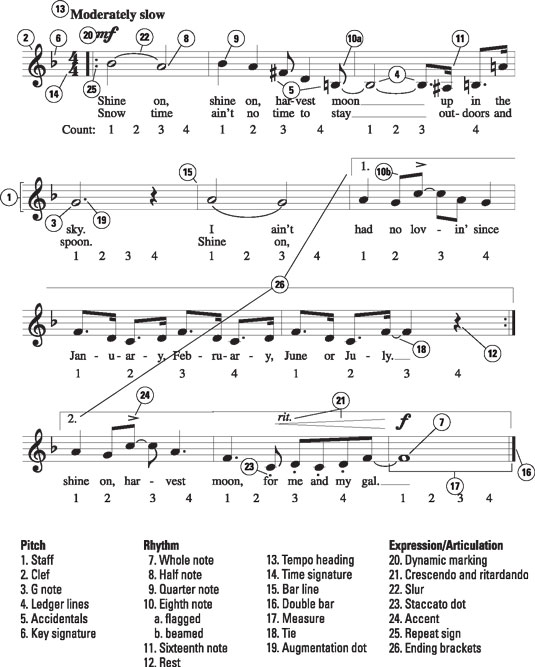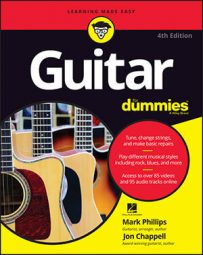A note's shape helps tell how long you need to hold it. Notes can have a hollow note head (as in the case of the whole note and half note) or a solid note head (quarter notes, eighth notes, and 16th notes), and the solid note heads can even have vertical lines (called stems) with flags (curly lines) dangling off them. If you join together two or more notes, beams (horizontal lines between the stems) replace the flags.
The table refers to the symbols numbered from 7 to 19 in the following figure.

Music for "Shine On Harvest Moon."
| Number in Figure | What It's Called | What It Means |
|---|---|---|
| 7 | Whole note | The longest note is the whole note, which has a hollow oval head with no stem. |
| 8 | Half note | The half note has a hollow oval head with a stem. It lasts half as long as the whole note. |
| 9 | Quarter note | The quarter note has a solid oval head with a stem. It lasts half as long as the half note. |
| 10 | Eighth note | The eighth note has a solid oval head with a stem and a flag (10a) or beam (10b). It lasts half as long as the quarter note. |
| 11 | 16th note | The 16th note has a solid oval head with a stem and either two flags or two beams. It lasts half as long as the eighth note. |
| 12 | Rest | Music consists not only of notes but also of silences. What makes music interesting is how the notes and silences interact. Silences in music are indicated by rests. The rest in the figure is a quarter rest, equal in duration to a quarter note. Other rests, also equal in duration to their corresponding notes, are the whole rest, half rest, eighth rest and 16th rest. |
| 13 | Tempo heading | The tempo heading tells you how fast or slow the song's beat, or pulse, is. As you listen to music, you (usually) hear an immediately recognizable beat. The beat is what you tap your foot or snap your fingers to. |
| 14 | Time signature | Most songs group their beats in twos, threes, or fours. A song's beats may, for example, sound out as "one-two-three-four, one-two-three-four, one-two-three-four" and not as "one-two-three-four-five-six-seven-eight-nine-ten-eleven-twelve." The time signature looks like a fraction (but actually is two numbers sitting one above the other, with no dividing line), and it tells you two things: First, the top number tells you how many beats make up one grouping. In "Shine On Harvest Moon," for example, the top number, 4, tells you that each grouping contains four beats. Second, the bottom number tells you which type of note (quarter note, half note, and so on) gets one beat. In this case, the bottom number, 4, tells you that the quarter note gets one beat. Assigning the quarter note one beat is very common and so is having four beats per grouping. In fact, 4/4 time is sometimes called simply common time, and you sometimes indicate it by using the letter C instead of the numbers 4/4. |
| 15 | Bar line | A bar line is a vertical line drawn through the staff after each grouping that the time signature indicates. In "Shine On Harvest Moon," a bar line appears after every four beats. |
| 16 | Double bar line | A double bar line indicates the end of a song. |
| 17 | Measure (bar) | The space between two consecutive bar lines is known as a measure, or bar. Each measure consists of the number of beats that the time signature indicates (in the case of the figure, four). Those four beats can comprise any combination of note values that add up to four beats. You may have four quarter notes, or two half notes, or one whole note, or one half note and one quarter and two eighth notes — or any other combination. You can even use rests (silences) as long as everything adds up to four. Check out each measure of "Shine On Harvest Moon" to see various combinations. |
| 18 | Tie | A short curved line that connects two notes of the same pitch is known as a tie. A tie tells you to not strike the second of the two notes but to sustain the first note for the combined time value of both notes. |
| 19 | Augmentation dot (also called a dot) | A dot appearing after a note increases that note's time value by half. If a half note is equal to two beats, for example, a dotted half note is equal to three — two plus half of two, or two plus one, or three. |

